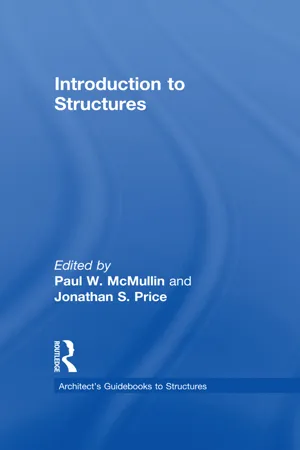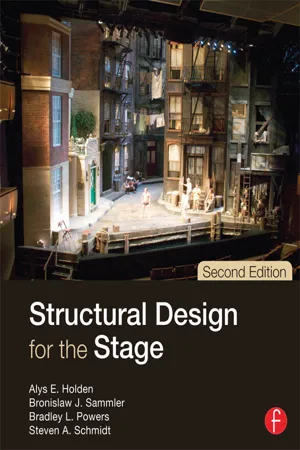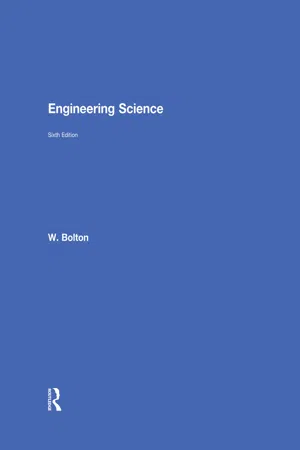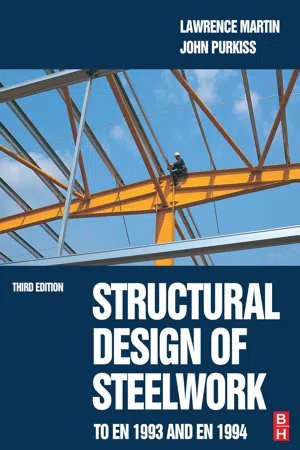Technology & Engineering
Method of Joints
The method of joints is a technique used in structural engineering to analyze and solve for the forces within a truss. It involves examining the equilibrium of forces at each joint in the truss structure to determine the internal forces acting on the individual members. By applying the principles of statics, engineers can use the method of joints to efficiently analyze and design truss structures.
Written by Perlego with AI-assistance
Related key terms
Related key terms
1 of 4
Related key terms
1 of 3
4 Key excerpts on "Method of Joints"
- eBook - ePub
- Paul McMullin, Jonathan Price, Paul W. McMullin, Jonathan S. Price(Authors)
- 2016(Publication Date)
- Routledge(Publisher)
Chapter 10Structural Analysis: Plane Trusses and FramesPaul W. McMullinTrusses and frames are structural systems consisting of many or just a few members. Before computers, engineers solved them manually. Some methods were exact; others approximate (using simplifying assumptions to make them statically determinate). Understanding classical methods of analysis imparts a fundamental understanding of truss and frame behavior and provides a way to validate computer analyses.10.1 Truss AnalysisWe use the Method of Joints, Method of Sections , or Graphical Methods to determine the member forces within trusses, such as those in Figure 10.1 or Figure 10.2 . Two assumptions reduce the number of variables to the available static equilibrium equations. First, members only carry axial load (along their length). Second, joints, where members connect, are pinned but free to rotate. The Method of Joints balances the loads and forces acting at a joint using the equilibrium equations presented in Chapter 5 . The Method of Sections balances the forces acting on a section of a truss using both Equations (5.1) and (6.1) (i.e. the sum of forces and moments on an object must equal zero). Graphical Methods provide another method to balance loads, reactions, and member forces in a geometrical way using Maxwell diagrams . These provide a visual understanding of the individual member forces.10.1.1 Method of Joints
Method of Joints centers on constructing a free body diagram at a joint (Figure 10.3 ) representing the members by a force, then summing forces in the × and y directions. The steps are as follows:-
Step 1: Draw the truss in plan and elevation assuming a depth based on span, available depth, and structural section and material
selection. This process is iterative between geometric constraints and preliminary sizing. There are no right or wrong answers, just options. Some more satisfactory than others.Figure 10.1 Harry S. Truman Bridge, Kansas City, Missouri, 1945
- eBook - ePub
- Alys Holden, Bronislaw Sammler, Bradley Powers, Steven Schmidt(Authors)
- 2015(Publication Date)
- Routledge(Publisher)
Figure 15.1 ).Force analysis in trusses can be greatly simplified if redundant members with no forces are identified early in the process. These zero-force members are usually ones which are horizontal or vertical. Zero force members can be determined by observation prior to any calculations.The Method of Joints is a logical extension of the technique used to analyze three member trusses and is illustrated in the following examples. Note that in the following examples, the stresses will be rounded when represented as vectors, but the precise values will be used in the calculations. Additionally, the joints are labeled for easy reference.Example 6. Analyze the force in each member of the truss drawn below. This tension truss follows the Pratt-flat truss pattern.The first step in truss analysis is to determine if the truss is statically determinate:Figure 15.21 Truss and loading condition for Example 6The truss is statically determinate, and there are no obvious zero force members. Next, calculate the reactions. Since this truss is symmetrically loaded each reaction equals one half of the total load. Note that the weight of the truss has been neglected:m = 61 j = 32m = 2 j − 361 = 2 ( 32 ) − 361 = 61 ✓R 1=R 2=W 2== 850 #1 , 700 #2Finally, the forces at each joint are analyzed. Picking a starting place can be intimidating, but there is usually little choice. Only an extreme end or a reaction point will have few enough variables to solve for the unknown forces. For example, the analysis cannot begin at joint 3 because it is impossible to determine how the vertical and diagonal members would share the downward load (see Figure 15.26 - eBook - ePub
- W. Bolton(Author)
- 2015(Publication Date)
- Routledge(Publisher)
Figure 20.8 ), the structural members being typically I-section beams, bars or channels which are fastened together at their ends by welding, riveting or bolts.Several assumptions are made in analysing simple trusses:Figure 20.8 Trusses- Each member can be represented as a straight line representing its longitudinal axes with external forces only applied at the ends of members. The joints between members are treated as points located at the intersection of the members. The weight of a member is assumed to be small compared with the forces acting on it.
- All members are assumed to be two-force members . For such a member, equilibrium occurs under the action of just two forces with the forces being of equal size and having the same line of action but in opposite directions so that a member is subject to either just tension or just compression (Figure 20.9 ). A member which is in tension is called a tie; a member that is in compression is called a strut . The convention is adopted of labelling tensile forces by positive signs and compressive forces by negative signs, this being because tensile forces tend to increase length whereas compressive forces decrease length.
Figure 20.9 Two-force members- All the joints are assumed to behave as pin-jointed and permit each end of a member to rotate freely about the joint. Thus the joint is capable of supporting a force in any direction. Welded and riveted joints can usually be assumed to behave in this way. Pin-jointed members can only be in tension or compression.
20.3 Bow's notation
Bow’s notation is a useful method of labelling the forces in a truss. The spaces between the members and their external forces and reactions are labelled using letters or numbers when working in a consistent direction, e.g. clockwise. The spaces inside the truss are then labelled when working in the same direction. The internal forces are labelled by the two letters or numbers on each side of them. Thus, in Figure 20.10 , letters are used to label the spaces and so the force in the member linking junctions 1 and 2 is F AF and the force in the member linking junctions 3 and 6 is F GH . In the illustration of Bow’s notation in Figure 20.10 , the joints were labelled independently of the spaces between forces. However, the space labelling can be used to identify the joints without the need for independent labelling for them. The joints are labelled by the space letters or numbers surrounding them when read in a clockwise direction. Thus, in Figure 20.10 - Lawrence Martin, John Purkiss(Authors)
- 2017(Publication Date)
- CRC Press(Publisher)
Chapter 7 / Structural Joints (EN 1993-1-8, 2005)7.1 INTRODUCTION
Structural steel connections, referred to as joints in the Code, are required to ensure continuity at the intersection members and foundations. They are also used to form splices and to construct brackets to support loads. Generally structural steel joints are composed of plates, or parts of sections, shop welded in controlled conditions and bolted together on site. Welding can be carried out on site but it needs to be carefully supervised and is limited because of the expense. The physical appearance of some joints is shown in Figs 7.22 and 7.23 .Structural joints transmit internal forces and moments in a structure and strength is of major importance. However, the rigidity of joints also needs to be considered. All joints are semi-rigid with associated small linear and larger rotational movements. The linear movements at a joint are generally small and generally need not be considered, but the rotational movements affect the distribution of forces and moments which must be taken into account in structural analysis.For theoretical purposes in the analysis of structures, joints are classified (Table 5.1 , EN 1993-1-8 (2005)) by strength and rigidity as:(a) Pinned – low moment of resistance. (b) Rigid – full strength and all deformations are insignificant. (c) Semi-rigid – characteristics of the connection lie between (a) and (b).These theoretical and practical descriptions are important to recognize when analyzing a structure to determine the distribution of forces and moments using global analysis (cl 5.1, EN 1993-1-8 (2005)). There are three methods of global analysis:
Index pages curate the most relevant extracts from our library of academic textbooks. They’ve been created using an in-house natural language model (NLM), each adding context and meaning to key research topics.
Explore more topic indexes
Explore more topic indexes
1 of 6
Explore more topic indexes
1 of 4



